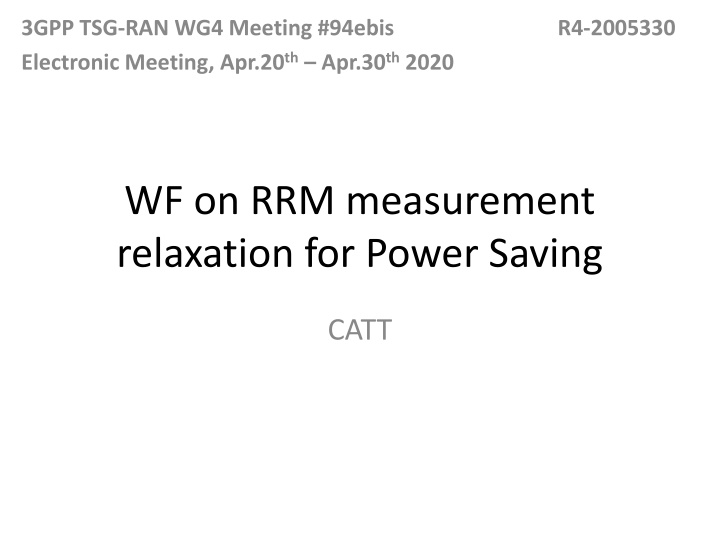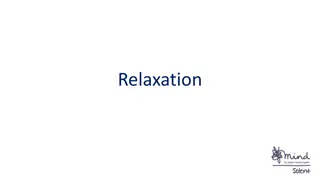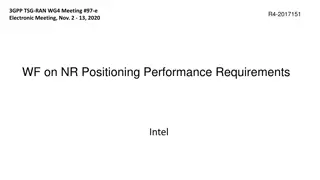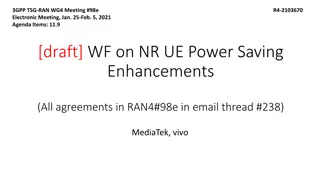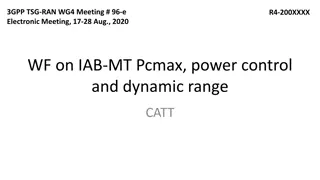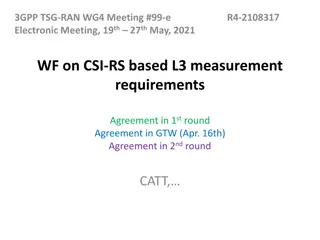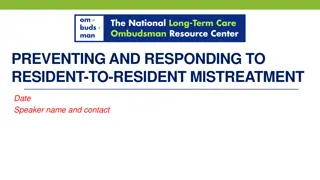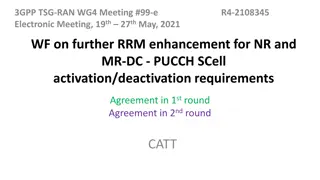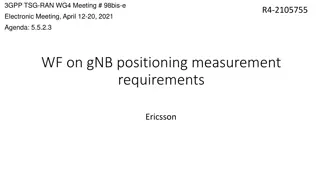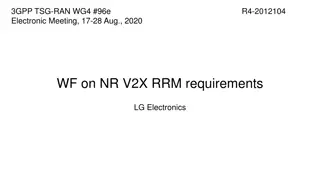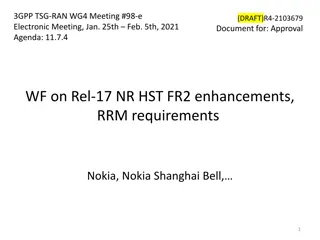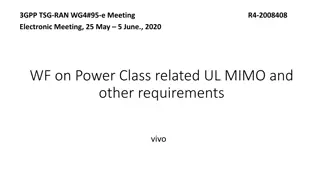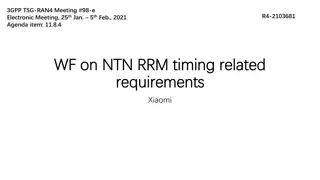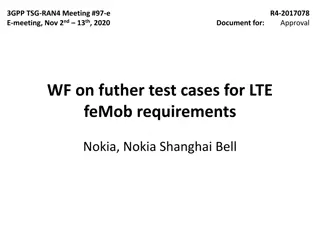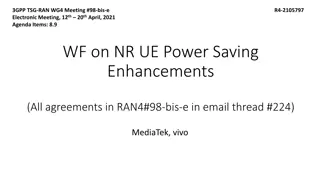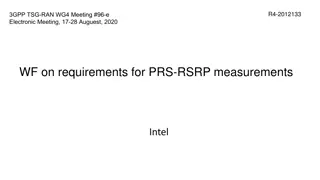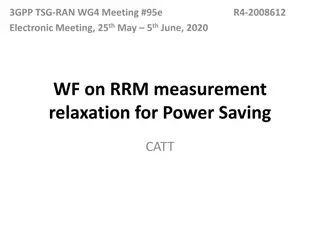RRM Measurement Relaxation for UE Power Saving in 3GPP Meeting #94ebis
This document discusses methods for relaxing RRM measurements to save power in UE devices during idle/inactive states. It covers scenarios with low mobility, non-cell edge, and combinations, suggesting options like longer measurement intervals and relaxing neighbor cell measurement requirements. The application of relaxation criteria and scaling factors for measurement intervals is detailed for different scenarios. The document also addresses relaxation methods for inter-frequency layers with higher priority in RRM measurements for power saving purposes.
Download Presentation

Please find below an Image/Link to download the presentation.
The content on the website is provided AS IS for your information and personal use only. It may not be sold, licensed, or shared on other websites without obtaining consent from the author.If you encounter any issues during the download, it is possible that the publisher has removed the file from their server.
You are allowed to download the files provided on this website for personal or commercial use, subject to the condition that they are used lawfully. All files are the property of their respective owners.
The content on the website is provided AS IS for your information and personal use only. It may not be sold, licensed, or shared on other websites without obtaining consent from the author.
E N D
Presentation Transcript
3GPP TSG-RAN WG4 Meeting #94ebis Electronic Meeting, Apr.20th Apr.30th2020 R4-2005330 WF on RRM measurement relaxation for Power Saving CATT
Background For information: Scenarios #1: Low mobility scenario #2: Not in cell-edge scenario #3: Low-mobility + Not in cell-edge scenario RRM measurement relaxation methods for UE power saving in RRC_idle/inactive state Option 1: Allow RRM measurements with longer intervals Option 2: UE is not required to meet the intra-frequency and inter- frequency neighbor cell measurement requirements Applicability of RRM relaxation methods when the relaxation criteria are fulfilled Applicable RRM relaxation methods Scenarios #1 Option 1 Scenarios #2 Option 1 Scenarios #3 Option 2
WF on RRM measurement relaxation Fixed scaling factor of measurement interval is used for scenario#1 and scenario#2 FFS the same value is used for scenario#1 and scenario#2 Option 1: the same value (Nokia, CATT, vivo, MTK, Qualcomm, CMCC, ZTE) Option 1: 2 times (CMCC, ZTE) Option 2: 4 times (Nokia, CATT, MTK, vivo, Qualcomm, Ericsson, NEC) Option 2: different value (Nokia, CATT, Ericsson, CMCC) 4 times for scenario#1 and 2 times scenario#2 (Ericsson, Nokia, CATT, CMCC, NEC) The scaling factor of RRM measurement relaxation with longer intervals shall apply to Tdetect, Tevaluate, and Tmeasure. The time interval for measurement relaxation since last measurement for cell reselection for scenario#3 (Low mobility and Not in cell-edge scenario) is 1 hour When network configures the parameters of both low mobility and not-at-cell- edge criteria, If network indicates option a, the relaxation method corresponding to scenario #3 when both relaxation criteria have been fulfilled If network indicates option b, the relaxation method corresponding to scenario #1 when only low mobility criteria is fulfilled the relaxation method corresponding to scenario #2 when only not-at-cell- edge criteria is met. FFS the relaxation method corresponding to scenario #3 when both relaxation criteria have been fulfilled
WF on RRM measurement relaxation RRM measurement relaxation for inter-frequency layer with higher priority When Srxlev> SnonIntraSearchPand Squal> SnonIntraSearchQ, no relaxation of the current measurement delay requirement is expected for inter-frequency measurement with higher priority. The agreement is only applicable when condition of scenario 2 is fulfilled and condition of scenario 1 is not fulfilled or not configured. UE can stop both equal/low priority and high priority inter-freq/inter-RAT measurements in scenario 3. When Srxlev SnonIntraSearchPor Squal SnonIntraSearchQ, the relaxed requirement for the frequency layer of higher priority shall use the same relaxed measurement requirement as those for the frequency layer of equal/lower priority. FFS the measurement relaxation method for higher priority carriers or equal/lower priority carriers applies to inter-RAT carrier with higher priority or equal/lower priority.
WF on RRM measurement relaxation RRM measurement relaxation by reducing the number of frequency layer to be measured No consensus to introduce the RRM measurement relaxation by reducing the number of frequency layer. No further discussion in RAN4. Transition period requirement Option 1: (MTK, Apple, CATT) When the intra/inter-frequency measurement transitions between any of two scenarios during one cell-reselection or measurement period, the cell re-selection or measurement requirements shall be the maximum of corresponding to the first mode before transition and the second mode after transition. Option 2: (Ericsson, Qualcomm, Nokia, NEC) When switching from scenario #1 or #2 to scenario #3, the UE shall fulfil the requirements corresponding to scenario #1 or #2 for N DRX cycles and thereafter switch to requirements corresponding to scenario #3 When switching from scenario #3 to scenario #1 or #2, the UE shall fulfil the requirements corresponding to scenario #1 or #2 upon fulfilling the switching criteria. When switching from normal mode to scenario #1/#2/#3, the UE shall fulfil the requirements corresponding to normal mode for N DRX cycles and thereafter switch to requirements corresponding to scenario #1/#2/#3 When switching from scenario #1/#2/#3 to normal mode, the UE shall fulfil the requirements corresponding to normal mode upon fulfilling the switching criteria. Option 3: (vivo) Define transition requirement between normal mode to relaxed mode (scenario 1/2/3) and vice versa Not define transition period between scenario 1/2 and 3 and vice versa
WF on RRM measurement relaxation FFS the triggering RRM relaxation mode Threshold mismatch between not at cell edge condition and cell centre condition The looser requirement (no requirement) is applied when the threshold configured for not-in-cell-edge condition is higher than that for cell center condition and both threshold conditions are fulfilled. UE will not do neighbor cell measurement. Not to introduce idle mode measurement accuracy requirements EMR impact in power saving mode Option 1: Measurements on EMR carriers should not be relaxed if T331 is running. (LGE, Nokia, CATT, Qualcomm, Ericsson, Apple, CMCC, NEC) Option 2: Measurements on EMR carriers shall be relaxedif T331 is running (vivo, MTK, Huawei)
WF on RRM measurement relaxation RRM measurement relaxation threshold for inter-frequency measurement Option 1: It is up to RAN2 s decision on whether to introduce carrier specific threshold for inter-frequency measurement relaxation. (Apple, CATT, CMCC, Huawei, Ericsson, Qualcomm, NEC) Option 2: Introduce carrier specific search thresholds for measurement relaxation. (LGE, Nokia, vivo) RRM impact due to cross-slot scheduling power saving technique Option 1: no RRM impact (Ericsson) Option 2: RAN1 will resolve the issue in RAN1 spec (CATT, vivo, MTK, Qualcomm, Huawei) Agreement: no further discussion in RAN4.
